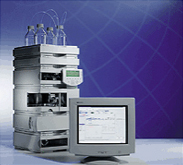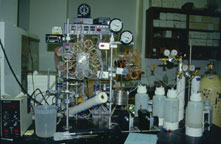

The
AAGL maintains two liquid chromatographs for separating and detecting amino acids. The conventional ion-exchange liquid chromatography separates isoleucine and alloisoleucine, which measures the extent of epimerization (racemization) in this amino acid. Reverse-phase liquid chromatography separates the D and L forms of several amino acids, most reliably: aspartic acid, glutamic acid, serine, alanine, and valine. Isoleucine and alloisoleucine are also resolved, but the uncertainty is higher compared with analysis by ion exchange. Most samples are analyzed by reverse phase, with emphasis on aspartic acid, an amino acid that is abundant in fossils and that racemizes rapidly. The chromatograph used for reverse phase is an Agilent series 1100 equipped with a quaternary pump and degasser, automated injector, fluorescence detector, and ChemStation software. The system is capable of highly reproducible stereoisomeric separations of amino acids with sub-picomole detection, sufficient for analysis of single microfossils (foraminifera and ostracodes).

 The AAGL maintains two liquid chromatographs for separating and detecting amino acids. The conventional ion-exchange liquid chromatography separates isoleucine and alloisoleucine, which measures the extent of epimerization (racemization) in this amino acid. Reverse-phase liquid chromatography separates the D and L forms of several amino acids, most reliably: aspartic acid, glutamic acid, serine, alanine, and valine. Isoleucine and alloisoleucine are also resolved, but the uncertainty is higher compared with analysis by ion exchange. Most samples are analyzed by reverse phase, with emphasis on aspartic acid, an amino acid that is abundant in fossils and that racemizes rapidly. The chromatograph used for reverse phase is an Agilent series 1100 equipped with a quaternary pump and degasser, automated injector, fluorescence detector, and ChemStation software. The system is capable of highly reproducible stereoisomeric separations of amino acids with sub-picomole detection, sufficient for analysis of single microfossils (foraminifera and ostracodes).
The AAGL maintains two liquid chromatographs for separating and detecting amino acids. The conventional ion-exchange liquid chromatography separates isoleucine and alloisoleucine, which measures the extent of epimerization (racemization) in this amino acid. Reverse-phase liquid chromatography separates the D and L forms of several amino acids, most reliably: aspartic acid, glutamic acid, serine, alanine, and valine. Isoleucine and alloisoleucine are also resolved, but the uncertainty is higher compared with analysis by ion exchange. Most samples are analyzed by reverse phase, with emphasis on aspartic acid, an amino acid that is abundant in fossils and that racemizes rapidly. The chromatograph used for reverse phase is an Agilent series 1100 equipped with a quaternary pump and degasser, automated injector, fluorescence detector, and ChemStation software. The system is capable of highly reproducible stereoisomeric separations of amino acids with sub-picomole detection, sufficient for analysis of single microfossils (foraminifera and ostracodes).
